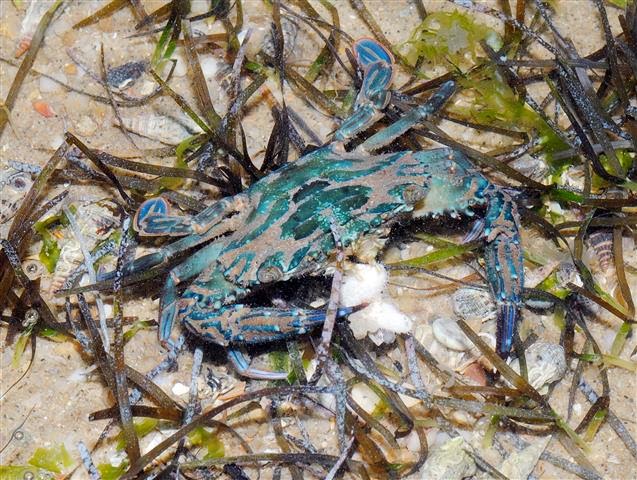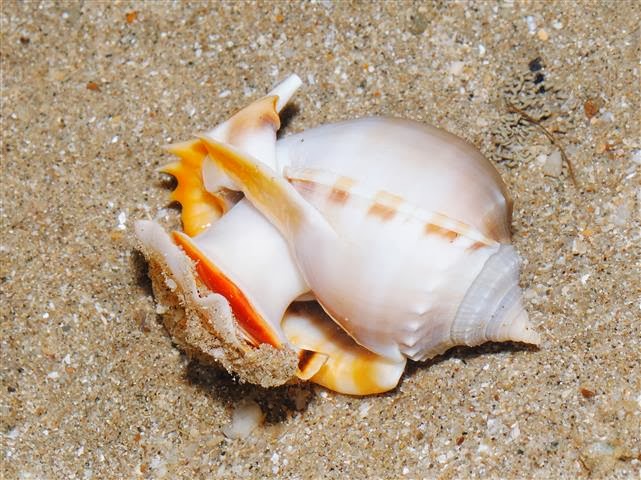On Lunar New Year Day 3, I decided to check out the idyllic sand flat at Tanah Merah / East Coast since the tide is still moderately low enough for a shore trip.
My previous trip here was last August in 2013 though I only spent a short moment exploring a huge stretch of shores along the East. The last trip that I properly surveyed this shore was as long as nearly 4 years ago in 2010 (before the oil spill event)!
Despite being alone, I was accompanied by tons of the Cake sand dollars (Arachnoides placenta) that prowl the sandy shore leaving behind trails along the "sandy highway".
What is so special about this shore would be many of these Button snails (Umbonium vestiarum) that are still doing very well on this shore that was once impacted by the oil spill. Unfortunately, the patches of button snails at Changi beach and Chek Jawa have been decimated, leaving this shore as one of the last strongholds of these pretty snails.
The buffet spread of these button snails are food to predatory snails such as the Ball moon snails (Polinices didyma).
The Spiral melongena (Pugilina cochlidium) is also another huge predator that demonstrates a huge snail eating small snails.
Here's a closer look at the intricate and amazing patterns of the button snails. No two shells look exactly alike (at least to me) and they are perfect examples of polymorphism in action.
Another group of creatures that are active on this reclaimed sandy shore would be many of these Striped hermit crabs (Clibanarius infraspinatus) that are crowding around each other. I think they are in the process of home exchange. Read more about their shell exchange here.
As first observed last year in August, seagrasses have started to colonize the shore and that is a great sign!
In this photo, you can see that the seagrasses appear in patches on the higher shores.
And they are more abundant on slightly lower elevation that remains covered with seawater on a moderately low tide like yesterday. There were also a bloom of Sea lettuce green seaweed (Ulva sp.) at certain stretches.
What type of seagrass can we find on this shore? The most abundant species would be the Spoon seagrass (Halophila ovalis).
There are also many of these Needle seagrass (Halodule sp.)!
Why are we so excited to see seagrasses on the shore? This is because seagrass meadows that create a miniature underwater forest. A host of small plants and animals thrive in these thickets. Seagrasses provide shelter for many animals that are not adapted for fast swimming and also provide a place for animals to lay their eggs, and for small animals to settle down.
This Blue swimming crab (Thalamita danae) that was found among the seagrasses was munching on some white bits that I could not distinguish.
Near the seawall, I was puzzled to find this stranded Thorny sea cucumber (Colochirus quadrangularis). Think it could be washed up from where the seagrass meadow is.
There were groups of people and families that were also on the shore having a good time relaxing during sunset.
I was on a lookout for the Fig snail (Ficus variegata) and it was a family that first found the special snail. As I was having a look at the fig snail, I also started sharing more about it with the people around me... and here I was activating my guiding mode since they looked interested to find out more.
I showed them my find of the pretty Olive snails (Family Olividae). These bullet-shaped snails are usually found on well-aerated, clean sand.
The family later found yet another two fig snails! Bravo! And after which, I also saw another two. So a total of five fig snails on a single trip.
As the night fell, the stars start to appear (this sentence has double meaning haha). The Plain sand stars (Astropecten indicus) started to "pop" out from the sand and showed themselves to the family of kids and adults around us. Timing was just right for me to continue my guiding mode without having to move too much.
And magically, at the same spot, this huge Painted sand star (Astropecten sp.) also appeared in front of us! So I went on to talk more about the wonders of sea stars aka starfishes.
So my solo trip on the shore was not-so-solo after all! With the company of people and animals!
After the family left as it became dark, I continued to look around and see what will appear in the dark. And true enough, I came across the Grey bonnet snail (Phalium glaucum)!
And I later also found yet another bonnet snail that just crawled out from the sand.
Another group of animals that appeared after night fall would be these small blue Tropical silversides (Atherinomorus duodecimalis) that leap from the water whenever light is shone onto it.
I also found a dead cone snail on the shore, which is evidence that these deadly fellow do lurk around somewhere! Hope to find a living one soon!
Looks like the shore has recovered well after the oil spill a few years ago and I saw no signs of oil beneath the sand as well. May the shore continue to be home to these fabulous creatures of the sea.






























3 comments:
Hey! How do you go there? I am an enthusiast for sealife as well and I would love to explore such areas! My trip to punggol beach sadly wasnt very fruitful so I'd love to try out another place! :)
Hi Gabriel, the shore is in front of NSRCC :) Do visit the shore on a low spring tide.
Post a Comment